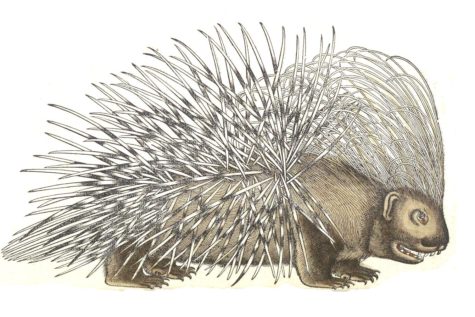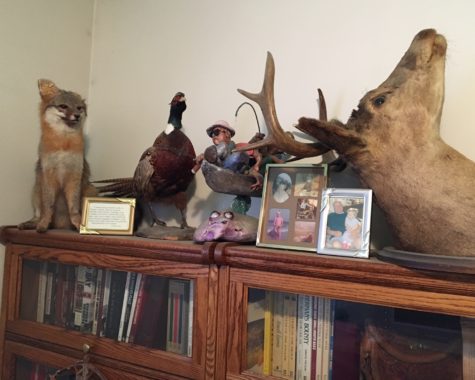 Not every juicy morsel works in every recipe. As a writer, I often come across something meaty, think, HUH! and then drag the link to a rarely visited desktop folder because, you know, I’m not writing a piece about using a dildo in zero gravity. (This time.) (Note to self: Pitch story on space-appropriate sex toys.)
Not every juicy morsel works in every recipe. As a writer, I often come across something meaty, think, HUH! and then drag the link to a rarely visited desktop folder because, you know, I’m not writing a piece about using a dildo in zero gravity. (This time.) (Note to self: Pitch story on space-appropriate sex toys.)
I’m actually working on an article about porcupines for National Wildlife magazine. My outline includes things like porcupine population dynamics and porcupine courtship rituals. It does not include anything about skinning and eating or stuffing and mounting porcupines.
Thank you LWON for giving me a safe space to investigate…whatever the hell.
In a 1957 article in the Journal of Forestry, David B. Cook and William J. Hamilton wrote of the porcupine: “While interesting to the nature lover and sentimentalist, it’s entirely devoid of any positive economic value—no useable pelt, no tasty flesh, nothing.”
Wrong! Because of the InterWebs I now know that not only do porky quills have value on Ebay, but some people find porcupine meat plenty edible. (Or at least a last resort if lost in the wilderness and really, really hungry.) The animals are big and slow (read: not hard to nab) and full of fat and protein. Apparently, the liver is delicious raw if you chill it in the snow before popping it in your mouth.
Porky Cooking Ideas from People on the InterWebs
Stuff the chest cavity with dressing and veggies just like a turkey, cover the whole works with foil. About a half hour before serving, pull off the foil, brush with butter, turn up the heat and brown lightly.
or
Cut the animal up more or less like a chicken, roll the pieces in flour, dip them in egg, then roll them in cracker crumbs and fry. Or use Shake and Bake and pop them in the oven.
or
Make porky pastries. Or porky-n-dumplings. Or porky pot pie.
Then there are those who appreciate the art of turning a roadkill porky into den art. Take that, Cook and Hamilton!
But preparing porcupine, whether to eat or to mount, has its special challenges. Yes, because of the jabby needles. An adult North American porcupine, after all, may have some 30,000 quills and each quill tip has backward-facing micro-barbs whose structure makes going in nice and easy but coming out a bitch and a half.
And once under your skin, a quill tip may migrate. One biologist told me about a piece that entered his palm and, days later, popped out of his upper arm.
But know this, porcupine handlers: Evolution has your back. Chemists have shown that porky quills are coated in a fatty-acid substance that has antibiotic properties; it inhibits at least six different bacterial strains. The reason this matters to porcupines is that males sometimes jab other males while arguing over females and, perhaps more important, porcupines, not uncommonly, fall out of trees. And land on their own sharp needles. Which penetrate.
Did you get that? Porcupines fall out of trees and self impale. It would be funny if it weren’t so tragic. Plus, did you even know porcupines climb trees? I didn’t.
Anyway, more than one in three museum specimens shows evidence of healed fractures consistent with a hard landing. I guess if infection set in every time a porcupine stabbed itself, Evolution would have lost her job a long time ago.
Even without the promise of a nasty inflammatory response, though, it’s best to avoid the subcutaneous quill.
And that’s why I’m sharing these tips I found in online chat rooms about preparing a porky. Because, especially for taxidermy, you’ll be doing a lot of needle avoidance and, probably, cussing, and you’ll need all the help you can get.
Taxidermy, after all, is not just taking a roadkill, putting a little hat on it, and propping it up against your elkhorn lamp. You have to take the animal apart and scoop out the bits that rot and then put the whole thing back together with fake parts that will last forever. (Note: Early taxidermists used to stuff animal skins with sawdust and rags, anatomy be damned. Nowadays people buy a mannequin or build a frame over which to stretch the skin, to give the animal back its natural shape.)
The first, most obvious rule I gleaned: Wear gloves, you idiot. Good, thick gloves. Keep your hands on the leather side of the pelt until you must touch the hair side, people say. A thick paper bag between you and the quills does wonders.
To make skinning easy, soak the whole porky in warm water for 30-45 minutes. This will soften and “de-barb” the quills temporarily (they’ll sharpen up again upon drying). Dawn dish detergent helps degrease and soften, and also masks “the stink that is porcupine.”
[Porcupines have glands on their back that give off a warning odor, in a substance disseminated by the quills. The stink, apparently, conveys in death. Some users call porkies “stinking grease pigs.”]
I’m not going to get further into degreasing, or into “fleshing,” “defatting,” “tanning,” or for that matter “pickling,” “staking,” and “drumming.” Because I’m not getting paid to research this and because ewww. But know that, to have a successful and long-lasting mount, you’ve got to get rid of all the animal protein to keep bacteria at bay. For the chemistry involved, check this out because I have no interest in summarizing it.
“Skin the feet as you want to skin them,” someone helpfully suggests on taxidermy.net. “You might want to save all the incisor teeth to embed in to the head of your form,” another recommends.
You will lose some quills in the soaking and handling, every porky taxidermist warns. Save and sell them, they say.
Once your animal looks like a 3-D animal again, the quills can be made to stand up nicely with proper grooming and “carding” (which utilizes props). There’s something called “hide paste” that can help, though Amazon doesn’t appear to carry it.
You still have your gloves on, right? You should.
My favorite bit of advice: “If you drop the porky, “DON’T TRY TO CATCH IT. Let it fall.” [Honey, why are you screaming and swearing as if your underwear caught fire? Is that a porcupine stuck to your hands?? How are you going to clean up all that blood if you can’t put down that porcupine??]
A side story about taxidermy: My father-in-law once found a dead fox alongside the road. It wasn’t a messy kill, so, naturally, he took it home. To the family’s surprise, Foxy—after disappearing into the garage of a guy in Virginia for a few weeks–soon took up residence in the corner of the den in a sit-and-watch pose. One day while visiting “Pop Pop” our Shiba Inu took issue with Foxy (there was quite a resemblance) and unceremoniously removed its left ear. The wound gave Foxy a certain James Bond coolness, like a scar or an eye patch. It read as DIDN’T BACK DOWN!
One-eared Foxy now sits on the bookcase in Pop-Pop’s office. I try to stay out of that room. There’s a really old buck head in there, and a dead bird or two, and god knows what else. Let’s just say we have different taste in decor. If someone offered him a mounted porcupine, I’m guessing he’d make room for it.
That’s all I’ve got to say on this subject.
Illustration: Conrad Gessner (* 1516; † 1565) : Porcupine, from the first volume of Historiae animalium (Zürich, 1551).
Foxy and Friends, by Ross Holland
So … are we saying that if you’re injured in the woods, a porcupine would make good wound dressing?
Interesting strategy. Let us know how it works out. (;
Not sure the opening joke about toys is needed. Think of the young readers.
Loved the rest
We have young readers?? That’s awesome!
Thank you for this morning’s laugh. It isn’t often Hacker News leads me to a place of good laughs. It isn’t often anywhere on the internet does so.